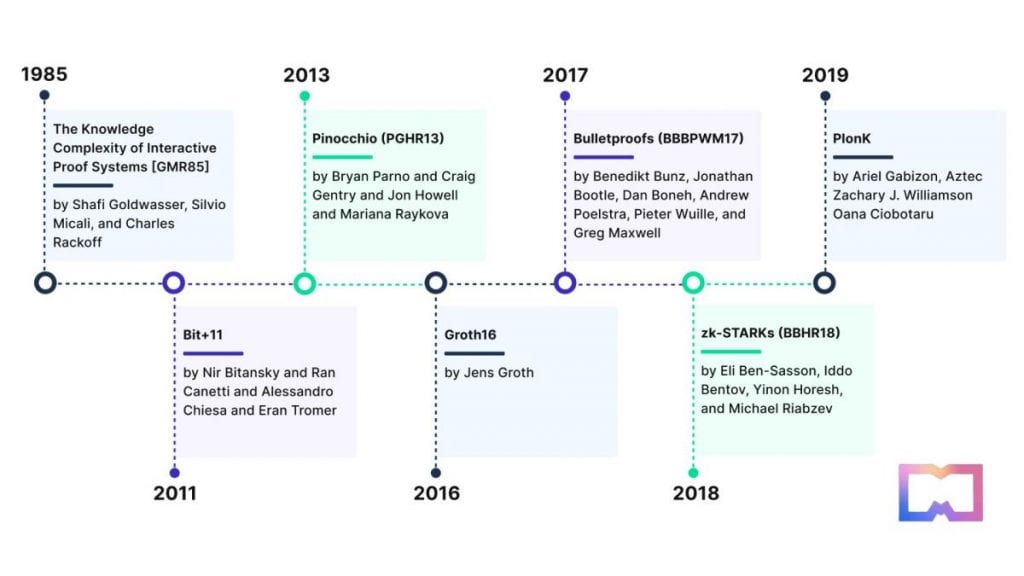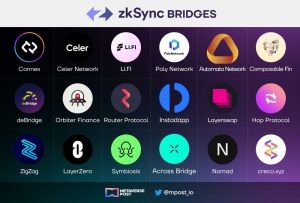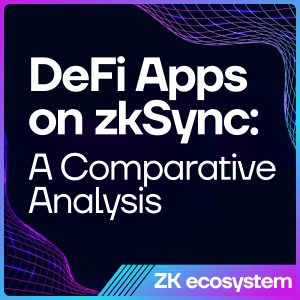History of Zero-Knowledge Proofs: From Cryptography to Blockchain


In Brief
Zero-knowledge proofs (ZK proofs) are cryptographic protocols that enable one party to convince another party that a given statement is true without revealing any additional information beyond the validity of the statement itself.
ZK proofs were introduced in 1985 by researchers Shafi goldwasser, Silvio Micali, and Charles Rackoff.
ZK proofs have gained attention in recent years for their direct application in blockchain technology.
In the realm of cryptography, one of the most intriguing and powerful concepts is that of zero-knowledge proofs (ZK proofs). These cryptographic protocols enable one party, known as the prover, to convince another party, known as the verifier, that a given statement is true without revealing any additional information beyond the validity of the statement itself. The history of ZK proofs is both fascinating and instrumental in various fields, including blockchain technology, privacy-preserving protocols, and secure communication.

Origins in the 1980s
The concept of zero-knowledge proofs was first introduced by researchers Shafi Goldwasser, Silvio Micali, and Charles Rackoff in the early 1980s. Their groundbreaking paper, published in 1985, laid the theoretical groundwork for ZK proofs. The authors demonstrated it is possible to construct protocols where a prover can convince a verifier of a statement’s truthfulness without revealing any additional information apart from the statement’s validity.
Three requirements characterize a zero-knowledge proof: completeness (the verifier is convinced when the statement is true), soundness (the verifier remains unconvinced when the statement is false), and zero knowledge (the prover does not leak any additional information). Achieving these three properties simultaneously was a significant breakthrough in cryptographic research.

Application to Cryptography
Following the foundational work on ZK proofs, researchers began exploring their applications in various cryptographic scenarios. For instance, ZK proofs found relevance in secure multi-party computation, where multiple parties wish to compute a joint function without revealing their private inputs. By employing ZK proofs, participants could ensure the correctness of their computations without disclosing sensitive information.
Moreover, ZK proofs played a pivotal role in the development of digital signatures and secure identification protocols. These cryptographic primitives rely on proving knowledge of a private key without revealing it. By using ZK proofs, individuals could authenticate themselves or prove ownership of a particular key without divulging the underlying secret.
ZK Proofs and Blockchain Technology
In recent years, zero-knowledge proofs have gained substantial attention due to their direct application in blockchain technology. Blockchain, the decentralized and transparent ledger behind cryptocurrencies like Bitcoin and Ethereum, poses challenges regarding privacy and scalability. ZK proofs offer a potential solution to these issues.
One prominent example is the concept of ZK-SNARKs (Zero-Knowledge Succinct Non-Interactive Argument of Knowledge), which allows the verification of transaction validity without revealing any sensitive information. With ZK-SNARKs, blockchain users can prove that a transaction is valid without sharing the details of the transaction itself. This breakthrough has significant implications for privacy, as it prevents transaction data from being publicly accessible while still maintaining the integrity of the blockchain.
The practical adoption of zero-knowledge proofs in blockchain technology has led to several real-world use cases. For instance, Zcash, a privacy-centric cryptocurrency, employs ZK-SNARKs to enable shielded transactions, where the sender, recipient, and transaction amount remain confidential. Similarly, other blockchain projects have leveraged ZK proofs to enhance privacy, scalability, and efficiency.

Continued Advancements
The evolution of zero-knowledge proofs did not stop with the advent of ZK-SNARKs. Researchers and cryptographers continue to make groundbreaking advancements in this field. New zero-knowledge proof systems, such as ZK-STARKs (Zero-Knowledge Scalable Transparent Arguments of Knowledge), aim to address limitations in efficiency and trust assumptions present in previous protocols.
Furthermore, zero-knowledge proofs are finding applications beyond cryptography and blockchain. They are being explored in areas such as secure voting systems, secure cloud computing, and privacy-preserving machine learning. The ability to provide mathematical guarantees without revealing sensitive information makes zero-knowledge proofs a powerful tool in protecting privacy and enabling secure interactions in various domains.
Conclusion
The history of zero-knowledge proofs is a testament to the remarkable progress made in cryptography. From its theoretical origins in the 1980s to practical applications in blockchain technology and beyond, ZK proofs have revolutionized how we approach privacy, security, and trust in digital systems.
As researchers and developers continue to push the boundaries of zero-knowledge proofs, we can anticipate even more innovative applications and improved protocols. The ongoing advancements in this field promise to shape the future of secure communication, privacy, and decentralized technologies, ensuring that individuals can exchange information and engage in transactions while preserving their confidentiality and maintaining trust in digital systems.
Read more:
- A Beginner’s Guide to the zkSync Ecosystem
- ZK-Proofs: What Is Zero Knowledge?
- ZK-Proofs: What Are the Benefits of ZK?
Disclaimer
In line with the Trust Project guidelines, please note that the information provided on this page is not intended to be and should not be interpreted as legal, tax, investment, financial, or any other form of advice. It is important to only invest what you can afford to lose and to seek independent financial advice if you have any doubts. For further information, we suggest referring to the terms and conditions as well as the help and support pages provided by the issuer or advertiser. MetaversePost is committed to accurate, unbiased reporting, but market conditions are subject to change without notice.
About The Author
Nik is an accomplished analyst and writer at Metaverse Post, specializing in delivering cutting-edge insights into the fast-paced world of technology, with a particular emphasis on AI/ML, XR, VR, on-chain analytics, and blockchain development. His articles engage and inform a diverse audience, helping them stay ahead of the technological curve. Possessing a Master's degree in Economics and Management, Nik has a solid grasp of the nuances of the business world and its intersection with emergent technologies.
More articles

Nik is an accomplished analyst and writer at Metaverse Post, specializing in delivering cutting-edge insights into the fast-paced world of technology, with a particular emphasis on AI/ML, XR, VR, on-chain analytics, and blockchain development. His articles engage and inform a diverse audience, helping them stay ahead of the technological curve. Possessing a Master's degree in Economics and Management, Nik has a solid grasp of the nuances of the business world and its intersection with emergent technologies.























































